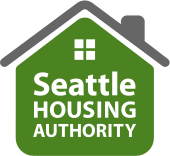SEATTLE—April 26, 2004—Seattle Housing Authority will adjust the mix of housing in its Scattered Sites portfolio over the next several years, in order to run the program more cost-effectively and to provide housing better suited to resident needs.
The Housing Authority plans to sell up to 200 Scattered Sites units. SHA will be applying to HUD in the immediate future for permission to sell up to 75 of these 200 units. These units will be replaced as they are sold with units that are more cost effective to manage and, where possible, better located to serve resident needs.
The low-density, "scattered" nature of the program will be preserved. The Scattered Sites housing bought to replace the housing units sold will be located in the same neighborhoods and will be suitable for families.
Overall, there will be fewer single-family houses in the portfolio, but appropriate family housing opportunities will be retained.
The Scattered Sites program was established in 1978 to locate lower-density public housing throughout the city. Today SHA operates 787 units in single family, duplex, triplex and small multifamily buildings through this program.
Throughout the process, Seattle Housing Authority will make sure that the housing needs of residents living in the housing that is sold will continue to be met. The housing authority will assist them with moving to other Scattered Sites or to other SHA housing. Every effort will be made to house families in their current neighborhoods if that is what they want. If possible, moves will be scheduled at a time that is least disruptive to them.
By buying and selling properties in the Scattered Sites portfolio over the next several years, the Housing Authority hopes to increase management efficiency and cost-effectiveness. This is part of a strategy to reduce dependence on declining public housing operating and capital subsidies. These sales will also generate revenue to help the Housing Authority meet its replacement housing commitments from the redevelopment of New Holly, Rainier Vista and High Point, without tapping into local or state subsidy funds.
Because there are over 200 single-family homes scattered throughout the city and more than 150 in duplex and triplex structures, this portfolio currently is the most expensive one SHA manages. By changing the mix of properties in this portfolio, the Housing Authority expects to continue to offer attractive rental alternatives to families while reducing operating costs. The creation of new mixed-income communities at New Holly, Rainier Vista and High Point, combined with the substantial increase in Housing Choice Vouchers over the past five years, affords attractive housing opportunities for this group of residents.
The Housing Authority's first priority for proceeds from these sales is to replace units sold with units in better locations for residents and more efficient configurations for management. The second priority will be to help fulfill unfunded HOPE VI replacement housing commitments.
SHA will strive to replace Scattered Sites housing in small batches, as units are sold, so that the total number of units available remains relatively stable. Units will be replaced in non-poverty neighborhoods throughout Seattle, including the north end. The Housing Authority will seek out new locations near transit, with easy access to shopping, parks, schools and neighborhood services that meet the needs of low-income residents.
Replacement units will be affordable to households with incomes at or below 30 percent of area median income. They will have two or more bedrooms and be suitable for families with children. They will blend seamlessly into their surrounding neighborhoods.
All the Scattered Sites properties were evaluated to see how well they met the needs of residents compared to how much they cost to manage and maintain. SHA took into consideration the fact that single family houses are very expensive to maintain, while small apartment buildings are more cost effective.
Evaluation factors also included: age and general condition; neighborhood quality including proximity to transit and neighborhood services; area concentrations of households in poverty from Census data; and the estimated market value of the property.
Through this evaluation, 146 units located in 107 properties were identified as "high priority to sell." Additional units may be added to this category in the future to reach the goal of 200.
